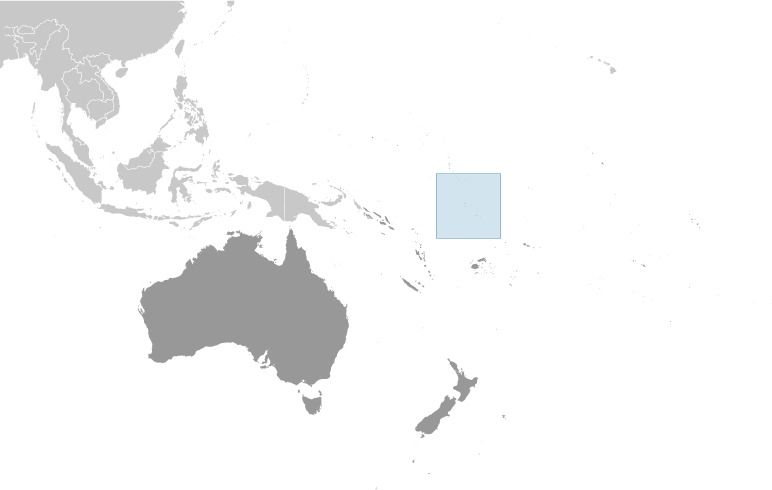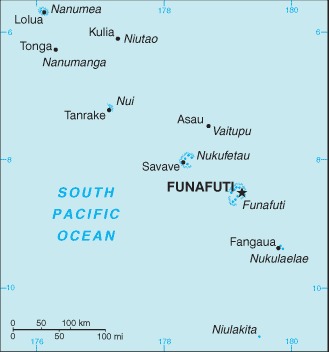


-
Introduction :: Tuvalu
-
Background:In 1974, ethnic differences within the British colony of the Gilbert and Ellice Islands caused the Polynesians of the Ellice Islands to vote for separation from the Micronesians of the Gilbert Islands. The following year, the Ellice Islands became the separate British colony of Tuvalu. Independence was granted in 1978. In 2000, Tuvalu negotiated a contract leasing its Internet domain name ".tv" for $50 million in royalties over a 12-year period. The agreement was subsequently renegotiated but details were not disclosed. Tuvalu hosted the Pacific Islands Forum Leaders Meeting in August 2019.
-
Geography :: Tuvalu
-
Location:Oceania, island group consisting of nine coral atolls in the South Pacific Ocean, about half way from Hawaii to AustraliaGeographic coordinates:8 00 S, 178 00 EMap references:OceaniaArea:total: 26 sq kmland: 26 sq kmwater: 0 sq kmcountry comparison to the world: 237Area - comparative:0.1 times the size of Washington, DCArea comparison map:
 The World Factbook Field Image ModalAustralia - Oceania :: Tuvalu Print
The World Factbook Field Image ModalAustralia - Oceania :: Tuvalu Print Image Description
Image Description0.1 times the size of Washington, DC
Land boundaries:0 kmCoastline:24 kmMaritime claims:territorial sea: 12 nmexclusive economic zone: 200 nmcontiguous zone: 24 nmClimate:tropical; moderated by easterly trade winds (March to November); westerly gales and heavy rain (November to March)Terrain:low-lying and narrow coral atollsElevation:mean elevation: 2 mlowest point: Pacific Ocean 0 mhighest point: unnamed location 5 mNatural resources:fish, coconut (copra)Land use:agricultural land: 60% (2011 est.)arable land: 0% (2011 est.) / permanent crops: 60% (2011 est.) / permanent pasture: 0% (2011 est.)forest: 33.3% (2011 est.)other: 6.7% (2011 est.)Irrigated land:0 sq km (2012)Population distribution:over half of the population resides on the atoll of FunafutiNatural hazards:severe tropical storms are usually rare, but in 1997 there were three cyclones; low levels of islands make them sensitive to changes in sea levelEnvironment - current issues:water needs met by catchment systems; the use of sand as a building material has led to beachhead erosion; deforestation; damage to coral reefs from increasing ocean temperatures and acidification; rising sea levels threaten water table; in 2000, the government appealed to Australia and New Zealand to take in Tuvaluans if rising sea levels should make evacuation necessaryEnvironment - international agreements:party to: Biodiversity, Climate Change, Climate Change-Kyoto Protocol, Desertification, Law of the Sea, Ozone Layer Protection, Ship Pollution, Whalingsigned, but not ratified: none of the selected agreementsGeography - note:one of the smallest and most remote countries on Earth; six of the nine coral atolls - Nanumea, Nui, Vaitupu, Nukufetau, Funafuti, and Nukulaelae - have lagoons open to the ocean; Nanumaya and Niutao have landlocked lagoons; Niulakita does not have a lagoon -
People and Society :: Tuvalu
-
Population:11,342 (July 2020 est.)country comparison to the world: 221Nationality:noun: Tuvaluan(s)adjective: TuvaluanEthnic groups:Tuvaluan 86.8%, Tuvaluan/I-Kiribati 5.6%, Tuvaluan/other 6.7%, other 0.9% (2012 est.)Languages:Tuvaluan (official), English (official), Samoan, Kiribati (on the island of Nui)Religions:Protestant 92.4% (Congregational Christian Church of Tuvalu 85.7%, Brethren 3%, Seventh Day Adventist 2.8%, Assemblies of God .9%), Baha'i 2%, Jehovah's Witness 1.3%, Mormon 1%, other 3.1%, none 0.2% (2012 est.)Age structure:0-14 years: 29.42% (male 1,711/female 1,626)15-24 years: 17.61% (male 1,031/female 966)25-54 years: 37.17% (male 2,157/female 2,059)55-64 years: 9.12% (male 427/female 607)65 years and over: 6.68% (male 289/female 469) (2020 est.)population pyramid:The World Factbook Field Image ModalAustralia - Oceania :: Tuvalu PrintImage DescriptionThis is the population pyramid for Tuvalu. A population pyramid illustrates the age and sex structure of a country's population and may provide insights about political and social stability, as well as economic development. The population is distributed along the horizontal axis, with males shown on the left and females on the right. The male and female populations are broken down into 5-year age groups represented as horizontal bars along the vertical axis, with the youngest age groups at the bottom and the oldest at the top. The shape of the population pyramid gradually evolves over time based on fertility, mortality, and international migration trends.
For additional information, please see the entry for Population pyramid on the Definitions and Notes page under the References tab.Median age:total: 26.6 yearsmale: 25.6 yearsfemale: 27.6 years (2020 est.)country comparison to the world: 152Population growth rate:0.87% (2020 est.)country comparison to the world: 119Birth rate:23.4 births/1,000 population (2020 est.)country comparison to the world: 53Death rate:8.2 deaths/1,000 population (2020 est.)country comparison to the world: 87Net migration rate:-6.5 migrant(s)/1,000 population (2020 est.)country comparison to the world: 207Population distribution:over half of the population resides on the atoll of FunafutiUrbanization:urban population: 64% of total population (2020)rate of urbanization: 2.27% annual rate of change (2015-20 est.)Major urban areas - population:7,000 FUNAFUTI (capital) (2018)Sex ratio:at birth: 1.05 male(s)/female0-14 years: 1.05 male(s)/female15-24 years: 1.07 male(s)/female25-54 years: 1.05 male(s)/female55-64 years: 0.7 male(s)/female65 years and over: 0.62 male(s)/femaletotal population: 0.98 male(s)/female (2020 est.)Infant mortality rate:total: 26.6 deaths/1,000 live birthsmale: 28.8 deaths/1,000 live birthsfemale: 24.2 deaths/1,000 live births (2020 est.)country comparison to the world: 66Life expectancy at birth:total population: 67.9 yearsmale: 65.6 yearsfemale: 70.2 years (2020 est.)country comparison to the world: 178Total fertility rate:2.88 children born/woman (2020 est.)country comparison to the world: 55Drinking water source:improved: urban: 100% of populationrural: 98.8% of populationtotal: 99% of populationunimproved: urban: 0% of populationrural: 1.2% of populationtotal: 1% of population (2017 est.)Current Health Expenditure:17.1% (2017)Physicians density:0.91 physicians/1,000 population (2014)Sanitation facility access:improved: urban: 91.8% of populationrural: 91% of populationtotal: 91.5% of populationunimproved: urban: 9.2% of populationrural: 9% of populationtotal: 8.5% of population (2017 est.)HIV/AIDS - adult prevalence rate:NAHIV/AIDS - people living with HIV/AIDS:NAHIV/AIDS - deaths:NAObesity - adult prevalence rate:51.6% (2016)country comparison to the world: 5Education expenditures:NAUnemployment, youth ages 15-24:total: 20.6%male: 9.8%female: 45.9% (2016)country comparison to the world: 65 -
Government :: Tuvalu
-
Country name:conventional long form: noneconventional short form: Tuvalulocal long form: nonelocal short form: Tuvaluformer: Ellice Islandsetymology: "tuvalu" means "group of eight" or "eight standing together" referring to the country's eight traditionally inhabited islandsGovernment type:parliamentary democracy under a constitutional monarchy; a Commonwealth realmCapital:name: Funafuti; note - the capital is an atoll of some 29 islets; administrative offices are in Vaiaku Village on Fongafale Isletgeographic coordinates: 8 31 S, 179 13 Etime difference: UTC+12 (17 hours ahead of Washington, DC, during Standard Time)etymology: the atoll is named after a founding ancestor chief, Funa, from the island of SamoaAdministrative divisions:7 island councils and 1 town council*; Funafuti*, Nanumaga, Nanumea, Niutao, Nui, Nukufetau, Nukulaelae, VaitupuIndependence:1 October 1978 (from the UK)National holiday:Independence Day, 1 October (1978)Constitution:history: previous 1978 (at independence); latest effective 1 October 1986amendments: proposed by the House of Assembly; passage requires at least two-thirds majority vote by the Assembly membership in the final reading; amended 2007, 2010, 2013Legal system:mixed legal system of English common law and local customary lawInternational law organization participation:has not submitted an ICJ jurisdiction declaration; non-party state to the ICCtCitizenship:citizenship by birth: yescitizenship by descent only: yes; for a child born abroad, at least one parent must be a citizen of Tuvaludual citizenship recognized: yesresidency requirement for naturalization: naSuffrage:18 years of age; universalExecutive branch:chief of state: Queen ELIZABETH II (since 6 February 1952); represented by Governor General Iakoba TAEIA Italeli (since 16 April 2010)head of government: Prime Minister Kausea NATANO (since 19 September 2019)cabinet: Cabinet appointed by the governor general on recommendation of the prime ministerelections/appointments: the monarchy is hereditary; governor general appointed by the monarch on recommendation of the prime minister; prime minister and deputy prime minister elected by and from members of House of Assembly following parliamentary electionselection results: Kausea NATANO elected prime minister by House of Assembly; House of Assembly vote count on 19 September 2019 - 10 to 6Legislative branch:description: unicameral House of Assembly or Fale I Fono (16 seats; members directly elected in single- and multi-seat constituencies by simple majority vote to serve 4-year terms)elections: last held on 9 September 2019 (next to be held on September 2023)election results: percent of vote - NA; seats - independent 16 (9 members reelected)Judicial branch:highest courts: Court of Appeal (consists of the chief justice and not less than 3 appeals judges); High Court (consists of the chief justice); appeals beyond the Court of Appeal are heard by the Judicial Committee of the Privy Council (in London)judge selection and term of office: Court of Appeal judges appointed by the governor general on the advice of the Cabinet; judge tenure based on terms of appointment; High Court chief justice appointed by the governor general on the advice of the Cabinet; chief justice serves for life; other judges appointed by the governor general on the advice of the Cabinet after consultation with chief justice; judge tenure set by terms of appointmentsubordinate courts: magistrates' courts; island courts; land courtsPolitical parties and leaders:there are no political parties but members of parliament usually align themselves in informal groupingsInternational organization participation:ACP, ADB, AOSIS, C, FAO, IBRD, IDA, IFAD, IFRCS (observer), ILO, IMF, IMO, IOC, ITU, OPCW, PIF, Sparteca, SPC, UN, UNCTAD, UNESCO, UNIDO, UPU, WHO, WIPO, WMODiplomatic representation in the US:none; the Tuvalu Permanent Mission to the UN serves as the Embassy; it is headed by Samuelu LALONIU (since 21 July 2017); address: 685 Third Avenue, Suite 1104, New York, NY 10017; telephone: [1] (212) 490-0534; FAX: [1] (212) 808-4975Diplomatic representation from the US:the US does not have an embassy in Tuvalu; the US Ambassador to Fiji is accredited to TuvaluFlag description:light blue with the flag of the UK in the upper hoist-side quadrant; the outer half of the flag represents a map of the country with nine yellow, five-pointed stars on a blue field symbolizing the nine atolls in the oceanNational symbol(s):maneapa (native meeting house); national colors: light blue, yellowNational anthem:name: "Tuvalu mo te Atua" (Tuvalu for the Almighty)lyrics/music: Afaese MANOA
note: adopted 1978; the anthem's name is also the nation's motto
-
Economy :: Tuvalu
-
Economic overview:
Tuvalu consists of a densely populated, scattered group of nine coral atolls with poor soil. Only eight of the atolls are inhabited. It is one of the smallest countries in the world, with its highest point at 4.6 meters above sea level. The country is isolated, almost entirely dependent on imports, particularly of food and fuel, and vulnerable to climate change and rising sea levels, which pose significant challenges to development.
The public sector dominates economic activity. Tuvalu has few natural resources, except for its fisheries. Earnings from fish exports and fishing licenses for Tuvalu’s territorial waters are a significant source of government revenue. In 2013, revenue from fishing licenses doubled and totaled more than 45% of GDP.
Official aid from foreign development partners has also increased. Tuvalu has substantial assets abroad. The Tuvalu Trust Fund, an international trust fund established in 1987 by development partners, has grown to $104 million (A$141 million) in 2014 and is an important cushion for meeting shortfalls in the government's budget. While remittances are another substantial source of income, the value of remittances has declined since the 2008-09 global financial crisis, but has stabilized at nearly $4 million per year. The financial impact of climate change and the cost of climate related adaptation projects is one of many concerns for the nation.
GDP real growth rate:3.2% (2017 est.)3% (2016 est.)9.1% (2015 est.)country comparison to the world: 94Inflation rate (consumer prices):4.1% (2017 est.)3.5% (2016 est.)country comparison to the world: 172Credit ratings:GDP (purchasing power parity) - real:$42 million (2017 est.)$40.68 million (2016 est.)$39.48 million (2015 est.)note: data are in 2017 dollars
GDP (official exchange rate):$40 million (2017 est.)GDP - per capita (PPP):$3,800 (2017 est.)$3,700 (2016 est.)$3,600 (2015 est.)note: data are in 2017 dollars
country comparison to the world: 167GDP - composition, by sector of origin:agriculture: 24.5% (2012 est.)industry: 5.6% (2012 est.)services: 70% (2012 est.)GDP - composition, by end use:government consumption: 87% (2016 est.)investment in fixed capital: 24.3% (2016 est.)exports of goods and services: 43.7% (2016 est.)imports of goods and services: -66.1% (2016 est.)Ease of Doing Business Index scores:Agriculture - products:coconuts; fishIndustries:fishingIndustrial production growth rate:-26.1% (2012 est.)country comparison to the world: 202Labor force:3,615 (2004 est.)country comparison to the world: 224Labor force - by occupation:note: most people make a living through exploitation of the sea, reefs, and atolls - and through overseas remittances (mostly from workers in the phosphate industry and sailors)
Unemployment rate:NA
Population below poverty line:26.3% (2010 est.)Household income or consumption by percentage share:lowest 10%: NAhighest 10%: NABudget:revenues: 42.68 million (2013 est.)expenditures: 32.46 million (2012 est.)note: revenue data include Official Development Assistance from Australia
Taxes and other revenues:106.7% (of GDP) (2013 est.)note: revenue data include Official Development Assistance from Australia
country comparison to the world: 1Budget surplus (+) or deficit (-):25.6% (of GDP) (2013 est.)country comparison to the world: 1Public debt:37% of GDP (2017 est.)47.2% of GDP (2016 est.)country comparison to the world: 142Fiscal year:calendar yearCurrent account balance:$2 million (2017 est.)$8 million (2016 est.)country comparison to the world: 64Exports:$600,000 (2010 est.)$1 million (2004 est.)country comparison to the world: 220Exports - partners:US 18.2%, Bosnia and Herzegovina 17%, Fiji 14.8%, Nigeria 14.2%, Germany 8.2%, South Africa 5.9%, Colombia 5.1% (2017)Exports - commodities:copra, fishImports:$20.69 billion (2018 est.)$19.09 billion (2017 est.)country comparison to the world: 81Imports - commodities:food, animals, mineral fuels, machinery, manufactured goodsImports - partners:Singapore 33.4%, South Korea 11.5%, Australia 10.8%, NZ 8%, Fiji 7.5%, Chile 6.1%, South Africa 5%, Japan 5% (2017)Debt - external:NA
Exchange rates:Tuvaluan dollars or Australian dollars (AUD) per US dollar -1.311 (2017 est.)1.3442 (2016 est.) -
Energy :: Tuvalu
-
Electricity access:electrification - total population: 100% (2020)Electricity - production:11.8 million kWh (2011 est.)country comparison to the world: 214Electricity - exports:0 kWh (2014 est.)country comparison to the world: 212Electricity - imports:0 kWh (2014 est.)country comparison to the world: 214Electricity - installed generating capacity:5,100 kW (2011 est.)country comparison to the world: 211Electricity - from fossil fuels:96% of total installed capacity (2015 est.)country comparison to the world: 42Electricity - from nuclear fuels:0% of total installed capacity (2014)country comparison to the world: 202Electricity - from hydroelectric plants:0% of total installed capacity (2014)country comparison to the world: 209Crude oil - production:0 bbl/day (2014 est.)country comparison to the world: 210Crude oil - exports:0 bbl/day (2014 est.)country comparison to the world: 210Crude oil - imports:0 bbl/day (2014 est.)country comparison to the world: 208Crude oil - proved reserves:0 bbl (2014 est.)country comparison to the world: 208Refined petroleum products - production:0 bbl/day (2014 est.)country comparison to the world: 211Refined petroleum products - exports:0 bbl/daycountry comparison to the world: 212Natural gas - production:0 cu m (2014 est.)country comparison to the world: 209Natural gas - consumption:0 cu m (2014)country comparison to the world: 209Natural gas - exports:0 cu m (2014 est.)country comparison to the world: 204Natural gas - imports:0 cu m (2014 est.)country comparison to the world: 205
-
Communications :: Tuvalu
-
Telephones - fixed lines:total subscriptions: 1,978subscriptions per 100 inhabitants: 17.59 (2019 est.)country comparison to the world: 218Telephones - mobile cellular:total subscriptions: 7,911subscriptions per 100 inhabitants: 70.36 (2019 est.)country comparison to the world: 215Telecommunication systems:general assessment: internal communications needs met; small global scale of over 11,000 people on 9 inhabited islands; mobile subscriber penetration about 40% and broadband about 10% penetration; govt. owned and sole provider of telecommunications services; 2G widespread; the launch in 2019 of the Kacific-1 satellite will improve the telecommunication sector for the Asia Pacific region (2020)domestic: radiotelephone communications between islands; fixed-line 18 per 100 and mobile-cellular 70 per 100 (2019)international: country code - 688; international calls can be made by satellitenote: the COVID-19 outbreak is negatively impacting telecommunications production and supply chains globally; consumer spending on telecom devices and services has also slowed due to the pandemic's effect on economies worldwide; overall progress towards improvements in all facets of the telecom industry - mobile, fixed-line, broadband, submarine cable and satellite - has moderatedBroadcast media:no TV stations; many households use satellite dishes to watch foreign TV stations; 1 government-owned radio station, Radio Tuvalu, includes relays of programming from international broadcasters (2019)Internet country code:.tvInternet users:total: 5,498percent of population: 49.32% (July 2018 est.)country comparison to the world: 216Broadband - fixed subscriptions:total: 1,000subscriptions per 100 inhabitants: 9 (2017 est.)country comparison to the world: 197
-
Transportation :: Tuvalu
-
Civil aircraft registration country code prefix:T2 (2016)Airports:1 (2013)country comparison to the world: 236Airports - with unpaved runways:total: 1 (2013)1,524 to 2,437 m: 1 (2013)Roadways:total: 8 km (2011)paved: 8 km (2011)country comparison to the world: 223Merchant marine:total: 243by type: bulk carrier 20, container ship 3, general cargo 39, oil tanker 24, other 157 (2019)country comparison to the world: 60Ports and terminals:major seaport(s): Funafuti
-
Military and Security :: Tuvalu
-
Military and security forces:no regular military forces; Tuvalu Police Force (2012)
-
Transnational Issues :: Tuvalu
-
Disputes - international:
none


